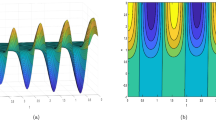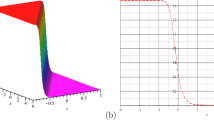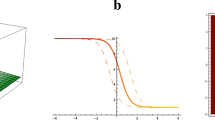Abstract
The Fokas-Lenells (FL) equation, which is rich in physical property in soliton theory as well as optical fiber, is a generalization of the higher-order Schrödinger equation. We construct the periodic solutions of the FL equation based on the Jacobi elliptic function expansion method in this context. Moreover, the characteristics of the obtained solutions are visualized graphically by selecting appropriate parameters.
Similar content being viewed by others
1 Introduction
Many complex phenomena of nature can be described by a large number of nonlinear evolution equations [1–10], so studying soliton solutions of nonlinear evolution equations is significant [9–13]. In recent years, the research of soliton theory has been penetrated into different areas, for instance, the plasma physics, fluid mechanics, and optics [11–20].
In nonlinear optics, many equations have been modeled to structure the propagation of optical pulses in various media [21–27]; the most famous equation of which is nonlinear Schrödinger equation (NLSE) [28, 29]. However, the Fokas-Lenells (FL) equation (1.1) was first proposed and derived by Fokas and Lenells via the bi-Hamiltonian method, which is a generalization of the NLSE [30–32],
where \(q(y,t)\) represents soliton profile, and asterisk denotes conjugate complex, α represents velocity dispersion, γ represents the self-phase modulation coefficient, β the Space-time dispersion coefficient, and σ the nonlinear dispersion coefficient, while y and t denote space and time variables, respectively. Equation (1.1) and NLSE is equivalent to the Camassa-Holm equation and KdV equation in correlation [33, 34]. By gauge transformation, Eq. (1.1) can be reduced to a simple form,
As all we know, many scholars have done a lot of work on the solution of FL system [35–44]. For example, the bright, dark, and singular soliton solutions of Eq. (1.2) are found by extended trial function method [35, 36]. Different kinds of exact solutions and analytical representation for the rogue waves of Eq. (1.2) are derived via the Darboux transformation [37–40]. A class of exact combined soliton solutions of Eq. (1.2) is obtained by the complex envelope function method [41]. The general dark N-soliton solution of Eq. (1.2) is constructed by the Hirota direct method [42]. Singular and combo-soliton solutions are presented using \(\exp(-\varphi (\xi ))\) function approach [43]. Exact explicit travelling wave solutions are given by the method of dynamical systems [44].
The Jacobi elliptic function expansion method takes the form of constructing solution to get new exact solutions, which plays an important role in obtaining exact solutions of many equations and models [45–49]. However, many researchers use the extended Jacobian elliptic function expansion method to obtain more general and richer solitary wave solutions of different physical models [50–55]. In this paper, we apply the extended Jacobian elliptic function method to solve new exact solutions of Eq. (1.2).
The overall framework of this paper will be designed as below. In Sect. 2, steps and hints of the method are listed. In Sect. 3, the periodic solutions and exact solutions of Eq. (1.2) are presented. Meanwhile, we draw some figures for those soliton solutions; the conclusion is given in the last section.
2 Program description
First, we state the general process of the Jacobi elliptic function expansion method [50–55]:
Suppose a nonlinear equation with two independent variable:
Applying the following transformation to Eq. (2.1)
we can get
here k shows wave number, and c is for wave speed.
Assume that the solution of Eq. (2.3) has a limited form of the extended Jacobi elliptic function:
where \(Y(\varsigma )=sn(\varsigma ,m)\) or \(cn(\varsigma ,m)\) or \(dn(\varsigma ,m)\) (\(0< m<1\)). The value of M can be solved by equating the highest order of the nonlinear term and the linear derivative term in Eq. (2.3). The value of \(d_{j}\) (\(j=-M,\ldots ,M\)) can be obtained by solving a system of equations, resulting from the substitution of Eq. (2.4) into (2.3), with a computer. Taking \(Y(\varsigma )\), M, and \(d_{j}\) into Eq. (2.4), we obtain a general expression for the solution of Eq. (2.1) in terms of the Jacobi elliptic function.
To make better use of this method, we note the following points:
1. Decision of the highest order
2. Identical relation
3. Derivative relations
4. Limit relation
3 Application to FLE
The solution of Eq. (1.2) can be supposed to be:
here k, c, a, and ω refer to real arbitrary constants.
Taking Eq. (3.1) into (1.2) and simplifying, we can obtain real and imaginary parts:
Using (2.5) in Eq. (3.2), we can obtain \(M=1\).
So, we can get:
3.1 Periodic solutions of FLE
Case 1: If \(Y ( \varsigma ) =sn ( \varsigma ,m )\)
Set 1:
Using Eq. (3.4) and (3.5), we obtain
Set 2:
Using Eq. (3.4) and (3.7), we obtain
Set 3:
Using Eq. (3.4) and (3.9), we obtain
Set 4:
Using Eq. (3.4) and (3.11), we obtain
Case 2: If \(Y ( \varsigma ) =cn ( \varsigma ,m )\)
Set 1:
Using Eq. (3.4) and (3.13), we obtain
Set 2:
Using Eq. (3.4) and (3.15), we obtain
Set 3:
Using Eq. (3.4) and (3.17), we obtain
Set 4:
Using Eq. (3.4) and (3.19), we obtain
Case 3: If \(Y ( \varsigma ) =dn ( \varsigma ,m )\)
Set 1:
Using Eq. (3.4) and (3.21), we obtain
Set 2:
Using Eq. (3.4) and (3.23), we obtain
Set 3:
Using Eq. (3.4) and (3.25), we obtain
Set 4:
Using Eq. (3.4) and (3.27), we obtain
3.2 Degradation
The following are degenerative forms of the above periodic solutions when \(m\rightarrow 1\):
Case 1: \(sn ( \varsigma ,m ) \rightarrow \tanh \varsigma \), then Eq. (3.6), (3.8), (3.10), and (3.12) are simplified to the following:
Case 2: \(cn ( \varsigma ,m ) \rightarrow \operatorname{sech} \varsigma \), then Eq. (3.14), (3.18), and (3.20) are simplified to the following:
Case 3: \(dn ( \varsigma ,m ) \rightarrow \operatorname{sech} \varsigma \), then Eq. (3.22), (3.24), and (3.26) are simplified to the following:
The following are degenerative forms of the above periodic solutions when \(m\rightarrow 0\):
Case 1: \(sn ( \varsigma ,m ) \rightarrow \sin \varsigma \), then Eq. (3.6), (3.8), and (3.10) are simplified to the following:
Case 2: \(cn ( \varsigma ,m ) \rightarrow \cos \varsigma \), then Eq. (3.14), (3.16), and (3.18) are simplified to the following:
3.3 Figure
In this part, we present some two- and three-dimensional graphs of Eq. (1.2) that we have solved in part 3.2.
By selecting particular parameters, Figs. 1–5 show the solitary wave of \(q ( y,t )\). From the two-dimensional graphs, the amplitude of the solition wave doesn’t change over time, but their spatial position shifts.
Graphs of the solitary wave for (3.33) with \(m\rightarrow 1\), \(a=1\), \(c=1\), \(k=1\)
Graphs of the solitary wave for (3.36) with \(m\rightarrow 0\), \(a=1\), \(c=0.1\), \(k=1\)
Graphs of the solitary wave for (3.34) with \(m\rightarrow 1\), \(a=2\), \(c=0.6\), \(k=0.01\)
Graphs of the solitary wave for (3.37) with \(m\rightarrow 0\), \(a=2\), \(c=0.6\), \(k=0.01\)
Graphs of the solitary wave for (3.35) with \(m\rightarrow 1\), \(a=1\), \(c=1\), \(k=1\)
4 Summary
We apply the extended Jacobi elliptic function expansion scheme to the Fokas-Lenells equation; moreover, the periodic wave solutions are obtained. In particular, when \(m\rightarrow 1\) and \(m\rightarrow 0\), these periodic solutions are degraded to solitary solutions, and their graphs are drawn in two cases.
Availability of data and materials
This paper does not require data and materials.
References
John, R.B., Francis, P.B.: The critical layer for internal gravity waves in a shear flow. J. Fluid Mech. 27(3), 513–539 (1967)
Labidi, M., Ebadi, G., Zerrad, E., Biswas, A.: Analytical and numerical solutions of the Schrödinger-KdV equation. Pramana J. Phys. 78(1), 59–90 (2012)
Biswas, A., Rezazadeh, H., Mirzazadeh, M.: Optical soliton perturbation with Fokas–Lenells equation using three exotic and efficient integration schemes. Optik 165, 288–294 (2018)
Liu, Y., Li, B., An, H.L.: General high-order breathers, lumps in the (2 + 1)-dimensional Boussinesq equation. Nonlinear Dyn. 92(4), 2061–2076 (2018)
Zhou, Q., Biswas, A.: Optical soliton in parity-time-symmetric mixed linear and nonlinear lattice with non-Kerr law nonlinearity. Superlattices Microstruct. 109, 588–598 (2017)
Xu, H., Ma, Z., Fei, J., Zhu, Q.: Novel characteristics of lump and lump–soliton interaction solutions to the generalized variable-coefficient Kadomtsev–Petviashvili equation. Nonlinear Dyn. 98(1), 551–560 (2019)
Shen, S., Yang, Z.J., Pang, Z.G., Ge, Y.R.: The complex-valued astigmatic cosine-Gaussian soliton solution of the nonlocal nonlinear Schrödinger equation and its transmission characteristics. Appl. Math. Lett. 125, 107755 (2022)
Osman, M.S., Machado, J.A.T., Baleanu, D.: On nonautonomous complex wave solutions described by the coupled Schrödinger-Boussinesq equation with variable coefficients. Opt. Quantum Electron. 50(2), 1–11 (2018)
Abdel-Gawad, H.I., Tantawy, M., Osman, M.S.: Dynamic of DNA′s possible impact on its damage. Math. Methods Appl. Sci. 39(2), 168–176 (2016)
Lü, X., Lin, F.: Soliton excitations and shape-changing collisions in alpha helical proteins with interspine coupling at higher order. Commun. Nonlinear Sci. Numer. Simul. 32, 241–261 (2016)
Arshad, M., Seadawy, A.R., Lu, D.C.: Exact bright-dark solitary wave solutions of the higher-order cubicquintic nonlinear Schrödinger equation and its stability. Optik 128, 40–49 (2017)
Arshad, M., Seadawy, A.R., Lu, D.C.: Optical soliton solutions of the generalized higher-order nonlinear Schrödinger equations and their applications. Opt. Quantum Electron. 50, 421 (2017)
Eslami, M., Neirameh, A.: New exact solutions for higher order nonlinear Schrödinger equation in optical fibers. Opt. Quantum Electron. 50, 47 (2018)
Lu, C.N., Fu, C., Yang, H.W.: Time-fractional generalized Boussinesq equation for Rossby solitary waves with dissipation effect in stratified fluid and conservation laws as well as exact solutions. Appl. Math. Comput. 327, 104–116 (2018)
Liu, J.G., Tian, Y., Hu, J.G.: New non-traveling wave solutions for the (3 + 1)-dimensional Boiti-Leon-Manna-Pempinelli equation. Appl. Math. Lett. 79, 162–168 (2018)
Liu, J.G.: Lump-type solutions and interaction solutions for the (2 + 1)-dimensional generalized fifth-order KdV equation. Appl. Math. Lett. 86, 36–41 (2018)
Song, L.M., Yang, Z.J., Zhang, S.M., Li, X.L.: Dynamics of rotating Laguerre-Gaussian soliton arrays. Opt. Express 27(19), 26331–26345 (2019)
Gao, X.Y.: Mathematical view with observational experimental consideration on certain (2 + 1)-dimensional waves in the cosmic laboratory dusty plasmas. Appl. Math. Lett. 91, 165–172 (2019)
Ding, C.C., Gao, Y.T., Li, L.Q.: Breathers and rogue waves on the periodic background for the Gerdjikov-Ivanovequation for the Alfvé waves in an astrophysical plasma. Chaos Solitons Fractals 120, 259–265 (2019)
Biswas, A.: Optical soliton perturbation with Radhakrishnan-Kundu-Laksmanan equation by traveling wave hypothesis. Optik 171, 217–220 (2018)
Tchokouansi, H.T., Kuetche, V.K., Kofane, T.C.: On the propagation of solitons in ferrites: the inverse scattering approach. Chaos Solitons Fractals 86, 64–74 (2016)
Tchokouansi, H.T., Kuetche, V.K., Kofane, T.C.: Exact soliton solutions to a new coupled integrable short light-pulse system. Chaos Solitons Fractals 68, 10–19 (2014)
Younis, M., Sulaiman, T.A., Bilal, M., Rehman, S.U., Younas, U.: Modulation instability analysis, optical and other solutions to the modified nonlinear Schrödinger equation. Commun. Theor. Phys. 72(6), 065001 (2020)
Younis, M.: Optical solitons in (n + 1) dimensions with Kerr and power law nonlinearities. Mod. Phys. Lett. B 31(15), 1750186 (2017)
Younis, M., Bilal, M., Shafqat-ur-Rehman, Younas, U., Rizvi, S.T.R.: Investigation of optical solitons in birefringent polarization preserving fibers with four-wave mixing effect. Int. J. Mod. Phys. B 34(11), 2050113 (2020)
Ali, S., Younis, M.: Rogue wave solutions and modulation instability with variable coefficient and harmonic potential. Front. Phys. 7, 255–262 (2020)
Younas, B., Younis, M.: Chirped solitons in optical monomode fibres modelled with Chen–Lee–Liu equation. Pramana J. Phys. 94(1), 1–5 (2020)
Agrawal, G.P.: Nonlinear fiber optics: its history and recent progress. J. Opt. Soc. Am. B 28(12), A1–A10 (2011)
Biondini, G., Kovacic, G.: Inverse scattering transform for the focusing nonlinear Schrödinger equation with nonzero boundary conditions. J. Math. Phys. 55(3), 031506 (2014)
Fokas, A.S.: On a class of physically important integrable equations. Physica D 87(1–4), 145–150 (1995)
Lenells, J.: Exactly solvable model for nonlinear pulse prop-agation in optical fibers. Stud. Appl. Math. 123(2), 215–232 (2009)
Wang, X., Wei, J., Wang, L., Zhang, J.L.: Baseband modulation instability, rogue waves and state transitions in a deformed Fokas–Lenells equation. Nonlinear Dyn. 97(1), 343–353 (2019)
Lenells, J., Fokas, A.S.: On a novel integrable generalization of the nonlinear Schrödinger equation. Nonlinearity 22(1), 11–27 (2008)
Lenells, J., Fokas, A.S.: An integrable generalization of the nonlinear Schrödinger equation on the half-line and solitons. Inverse Probl. 25(11), 115006 (2009)
Biswas, A., Ekici, M., Sonmezoglu, A., Alqahtani, R.T.: Optical soliton perturbation with full nonlinearity for Fokas-Lenells equation. Optik 165, 29–34 (2018)
Biswas, A., Ekici, M.: Optical solitons with differential group delay for coupled Fokas-Lenells equation by extended trial function scheme. Optik 165, 102–110 (2018)
Zhang, Q.Y., Zhang, Y., Ye, R.: Exact solutions of nonlocal Fokas–Lenells equation. Appl. Math. Lett. 98, 336–343 (2019)
He, J.S., Xu, S.W., Porseziam, K.: Rogue waves of the Fokas-Lennels equation. J. Phys. Soc. Jpn. 81, 124007 (2012)
Zhang, Y., Yang, J.M., Chow, K.W., Wu, F.: Solitons breathers and rogue waves for the coupled Fokas-Lenells system via Darboux transformation. Nonlinear Anal., Real World Appl. 33, 237–252 (2017)
Xu, S.W., He, J.S., Cheng, Y., Porseizan, K.: The n-order rogue waves of Fokas-Lenells equation. Math. Methods Appl. Sci. 38(6), 1106–1126 (2015)
Triki, H., Wazwaz, A.M.: Combined optical solitary waves of the Fokas-Lenells equation. Waves Random Complex Media 27(4), 587–593 (2017)
Matsuno, Y.: A direct method of solution for the Fokas-Lenells derivative nonlinear Schrödinger equation: II. Dark soliton solutions. J. Phys. A, Math. Theor. 45(47), 475202 (2012)
Arshed, S., Biswas, A., Zhou, Q., Khan, S., Adesanya, S., Moshokoa, S.P., Belic, M.: Optical solitons pertutabation with Fokas-Lenells equation by \(\exp(-\varphi (\xi ))\)-expansion method. Optik 179, 341–345 (2019)
Li, J.B., Zhang, Y., Liang, J.L.: Bifurcations and exact travelling wave solutions for a new integrable nonlocal equation. J. Appl. Anal. Comput. 11(3), 1588–1599 (2021)
Liu, S.K., Fu, Z.T., Liu, S.D., Zhao, Q.: Jacobi elliptic function expansion method and periodic wave solutions of nonlinear wave equations. Phys. Lett. A 289(1–2), 69–74 (2001)
El-Wakil, S.A., Abdou, M.A., Elhanbaly, A.: New solitons and periodic wave solutions for nonlinear evolution equations. Phys. Lett. A 353(1), 40–47 (2006)
Fu, Z.T., Liu, S.K., Liu, S.D., Zhao, Q.: New Jacobi elliptic function expansion and new periodic solutions of nonlinear wave equations. Phys. Lett. A 290, 72–76 (2001)
Fan, E.G., Zhang, J.: Applications of Jacobi elliptic function method to special type nonlinear equations. Phys. Lett. A 305, 383–392 (2002)
Chen, Y., Wang, Q.: A new elliptic equation rational expansion method and its application to the shallow long wave approximate equations. Appl. Math. Comput. 173, 1163–1182 (2006)
Bhrawy, A.H., Hao, M.A., Biswas, A.: Cnoidal and snoidal wave solutions to coupled nonlinear wave equations by the extended Jacobi’s elliptic function method. Commun. Nonlinear Sci. Numer. Simul. 18(4), 915–925 (2013)
Zhang, H.Q.: Extended Jacobi elliptic function expansion method and its applications. Commun. Nonlinear Sci. Numer. Simul. 12(5), 627–635 (2007)
Abdou, M.A., Elhanbaly, A.: Construction of periodic and solitary wave solutions by the extended Jacobi elliptic function expansion method. Commun. Nonlinear Sci. Numer. Simul. 12(7), 1229–1241 (2007)
Zafar, A., Raheel, M., Ali, K.K., Razzaq, W.: On optical soliton solutions of new Hamiltonian amplitude equation via Jacobi elliptic functions. Eur. Phys. J. Plus 135(8), 674 (2020)
Murali, R., Porsezian, K., Kofane, T.C., Mohamadou, A.: Modulational instability and exact solutions of the discrete cubic-quintic Ginzburg-Landau equation. J. Phys. A, Math. Theor. 43(16), 165001 (2010)
Zhang, J., Abdelkawy, H.Q.: Soliton solutions of the AB system via the Jacobi elliptic function expansion method. Optik 244, 167541 (2021)
Acknowledgements
The work described in this paper is fully supported by Scientific and Technologial Innovation Programs of Higher Education Institutions in Shanxi (Project No.: 2020L0738) and Planning Subject for the 14th Five-Year Plan of Shanxi Province Education Sciences (Project No.: GH-21253). Thanks to every colleague in the research group who gave me help and support and put forward valuable suggestions.
Funding
The work described in this paper is fully supported by Scientific and Technologial Innovation Programs of Higher Education Institutions in Shanxi (Project No.: 2020L0738) and Planning Subject for the 14th Five-Year Plan of Shanxi Province Education Sciences (Project No.: GH-21253).
Author information
Authors and Affiliations
Contributions
Y-NZ is responsible for the construction of the whole idea of the paper, the writing of the paper and the drawing of images, and NW is responsible for the revision of the English grammar of the paper and the sorting of references. All authors read and approved the final manuscript.
Corresponding author
Ethics declarations
Ethics approval and consent to participate
This study does not involve human experiments and animal studies.
Competing interests
The authors declare no competing interests.
Rights and permissions
Open Access This article is licensed under a Creative Commons Attribution 4.0 International License, which permits use, sharing, adaptation, distribution and reproduction in any medium or format, as long as you give appropriate credit to the original author(s) and the source, provide a link to the Creative Commons licence, and indicate if changes were made. The images or other third party material in this article are included in the article’s Creative Commons licence, unless indicated otherwise in a credit line to the material. If material is not included in the article’s Creative Commons licence and your intended use is not permitted by statutory regulation or exceeds the permitted use, you will need to obtain permission directly from the copyright holder. To view a copy of this licence, visit http://creativecommons.org/licenses/by/4.0/.
About this article
Cite this article
Zhao, YN., Wang, N. The exact solutions of Fokas-Lenells equation based on Jacobi elliptic function expansion method. Bound Value Probl 2022, 93 (2022). https://doi.org/10.1186/s13661-022-01672-4
Received:
Accepted:
Published:
DOI: https://doi.org/10.1186/s13661-022-01672-4









